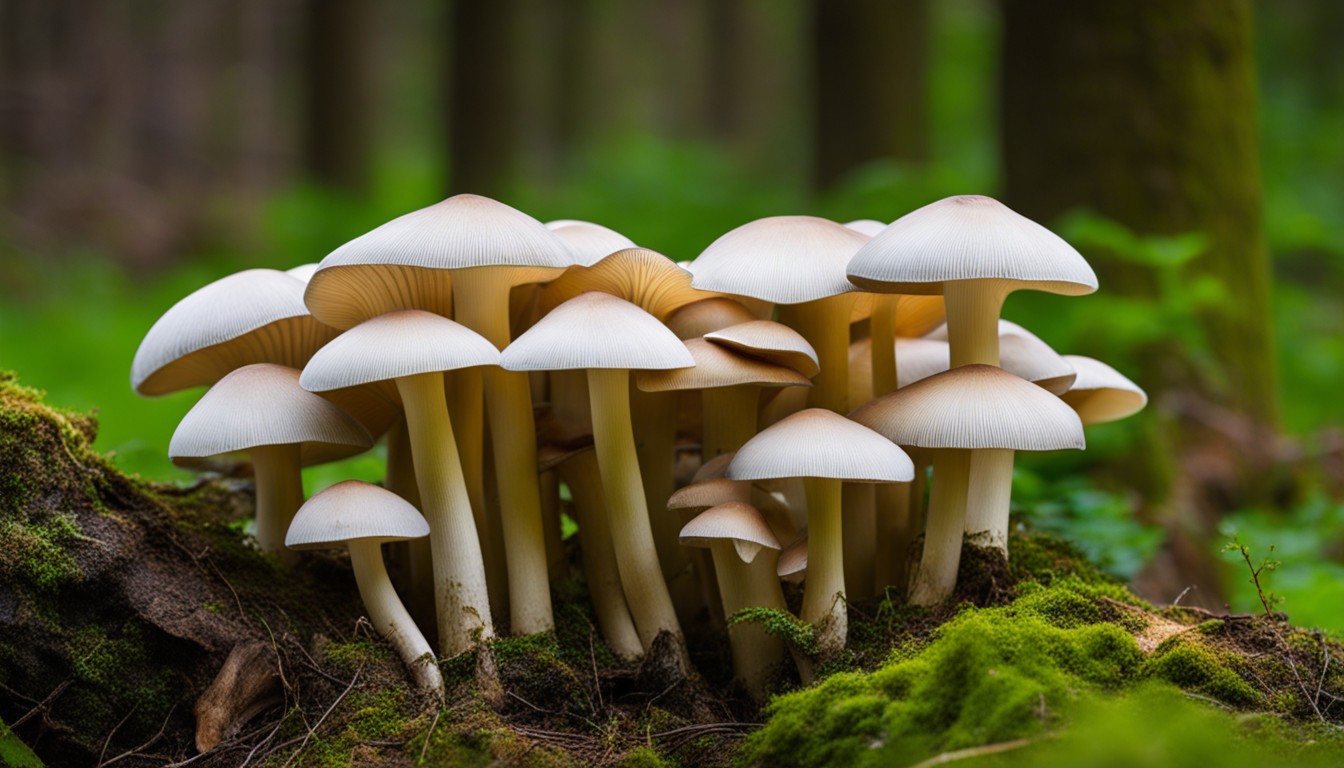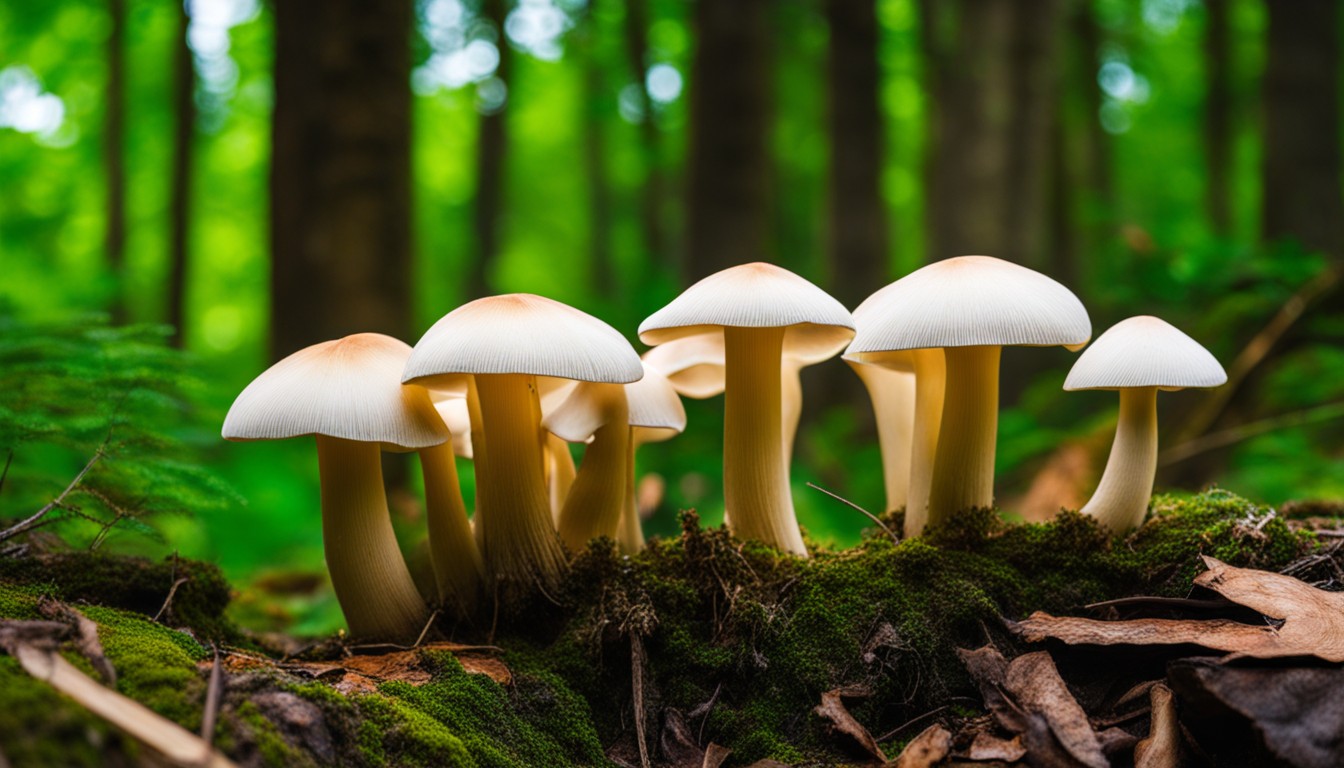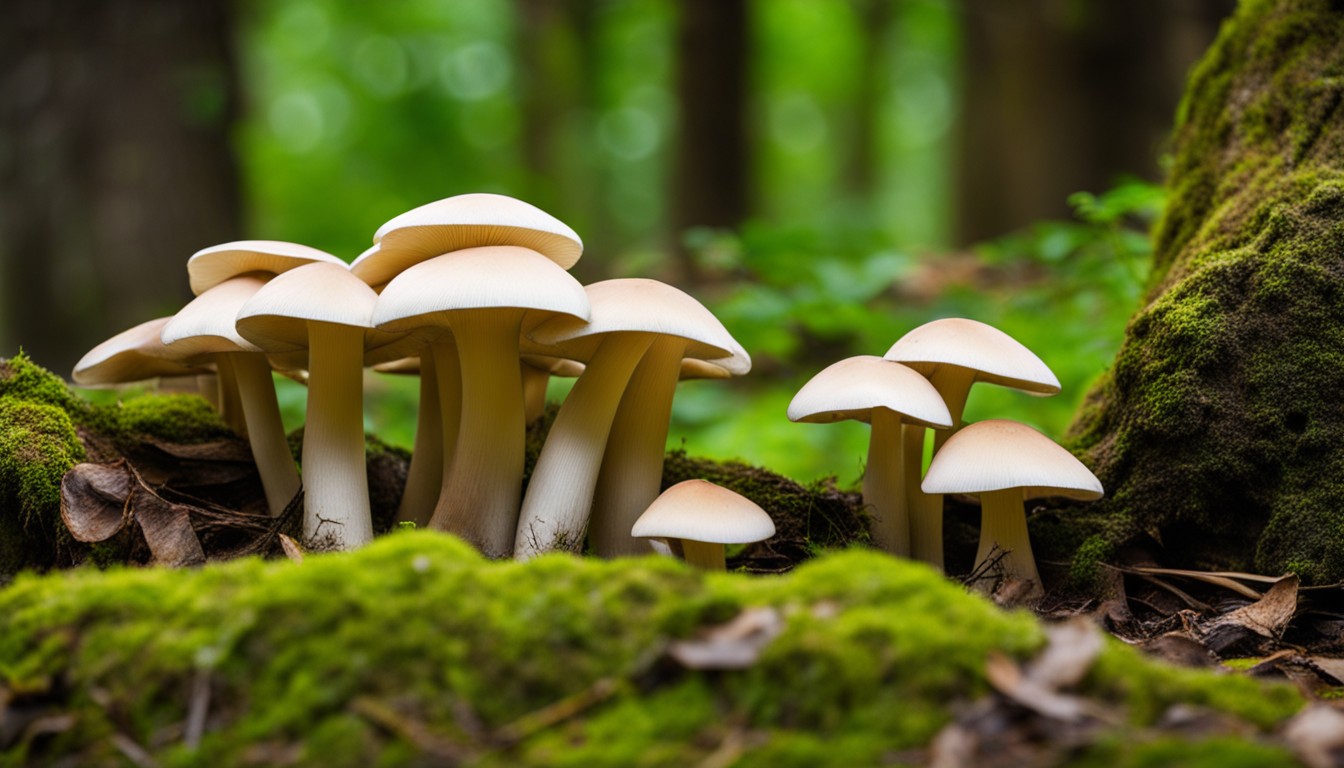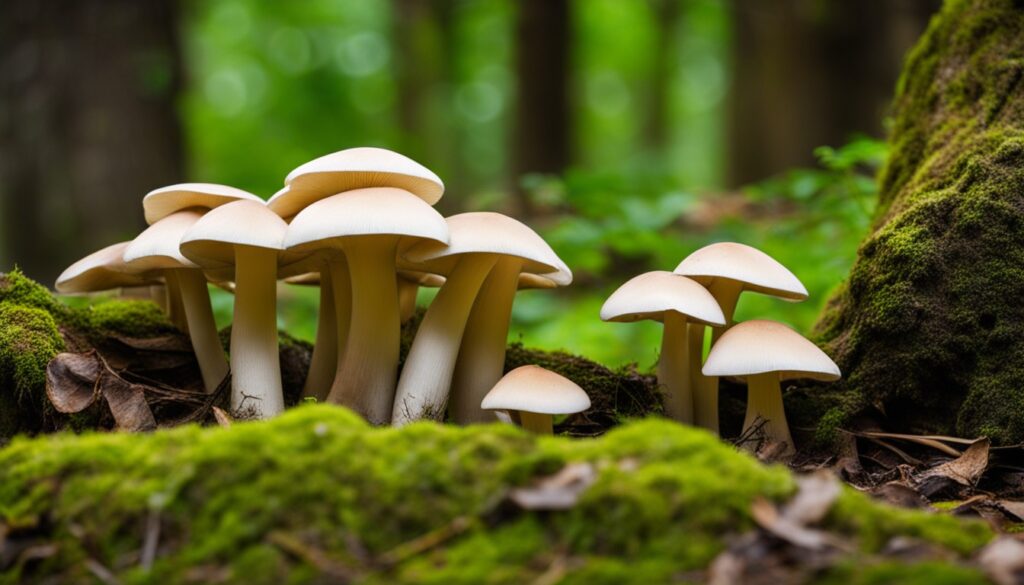In this comprehensive guide, we explore the diverse world of edible mushrooms found in North Carolina. From the majestic Morel to the flavorful Chanterelle, we highlight the unique characteristics, culinary uses, and foraging tips for each variety. Whether you are an avid mushroom hunter or simply a curious food enthusiast, this guide will deepen your understanding of the local delicacies and ignite your passion for exploring the rich biodiversity of North Carolina’s forests. Join us on this exciting journey as we uncover the hidden treasures of our state’s edible mushrooms.
Different Types of Edible Mushrooms in North Carolina
North Carolina is a rich oasis of edible mushrooms, home to a varied collection including Morels, Chanterelles, Lion’s Mane, Chicken of the Woods, and Oyster mushrooms. Each one offers a unique flavor profile and texture, and give the regional cuisine its distinctive taste.
North Carolina’s treasure trove of edible mushrooms, each with distinct textures and flavors, significantly influence the savory uniqueness of the region’s culinary culture.
Diversity thrives in North Carolina’s edible mushroom types. From taste differences to variations in texture, these fungi, native to the state, are key contributors to the unique flavour of local dishes produced region-wide.
Morel Mushrooms
In North Carolina, Morel mushrooms are highly coveted by both chefs and foragers alike, due to their unique taste and textural attributes. They have a honeycomb-like appearance, with their elongated, conical caps covered in a network of deep pits and ridges.
- These mushrooms are typically found under or near trees such as Elms, Ash, Poplar, and Apple trees.
- Morels usually emerge in early spring, especially after rainfall.
- They are very distinctive in their look which makes them relatively easy to identify, yet they present a challenge to find due their preferance for specific environmental conditions.
Chanterelle Mushrooms
Renowned for their funnel shape and delicate apricot hue, Chanterelle mushrooms pop against North Carolina’s forest floor. They’re sought after for their unique, slightly peppery taste and hearty texture, making them a prized ingredient in North Carolina’s culinary scene.
- Distinctive funnel shape and apricot color
- Peppery yet slightly fruity taste
- Hearty, meat like texture suitable for diverse recipes
- Peak availability during the rain-soaked summer months
Lion’s Mane Mushrooms
Lion’s Mane Mushrooms, scientifically named Hericium erinaceus, grace North Carolina’s hardwood forests with their unique, cascading spines. These delectable morsels, with a seafood-like flavor, make a memorable addition to culinary experiences.
- Lion’s Mane Mushrooms prefer hardwood trees, especially the beech.
- Its flavor profile has often been likened to shrimp or lobster.
- These mushrooms are best harvested in the fall, particularly in September and October.
- Cooking tip: Try sautéeing them in butter for a simple, tasty dish.
- Mushrooms should be cooked thoroughly before consumption to avoid potential irritation.
Chicken of the Woods Mushrooms
Chicken of the Woods, an unusual and fascinating type of mushroom, brings a burst of color and flavor to North Carolina forests. Recognized by its bright orange and yellow hue, it’s not just eye-catching but provides a wealth of nutritional benefits.
- Harvesting usually occurs in late summer and early fall
- It grows predominantly on hardwood trees, especially oaks
- Known for its chicken-like texture and taste
- High in protein, fiber, and vitamins
- Can be sautéed, grilled, or used in soups and stews
- Should be cooked thoroughly before consumption
- Young mushrooms are considered the most flavorful and tender
Oyster Mushrooms
Oyster Mushrooms, native to North Carolina, are a popular choice among health enthusiasts and gourmands alike. Rich in vitamins B and D, antioxidants, and dietary fiber, these irony gray delicacies add a distinctive taste and texture to a wide range of dishes.
- Combining them with garlic, white wine, and a touch of cream for a decadent pasta topper.
- Pan-searing them in butter and rosemary for a succulent side dish.
- Integrating them into a risotto for a rich, umami flavor.
- Using them in a stir-fry to bring a unique, mildly sweet taste to your meal.
When and Where to Find Edible Mushrooms in North Carolina

Mushroom hunting in North Carolina operates around the natural growth cycles. Spring and fall emerge as primetimes, with morel mushrooms coming up in spring, while fall favors lion’s mane, chicken of the woods, and oyster mushrooms.
Locality also plays a crucial role in mushroom discovery. The diversity of North Carolina’s landscape, ranging from humid coastal regions to high mountain terrains, provides an abundant mushroom variety, with the Smoky Mountains revealing particularly rich pickings.
Spring Mushroom Hunting
Advent of spring in North Carolina unveils an array of edible mushrooms for the enthusiastic foragers. Morel and Chanterelle mushrooms predominantly rule the season, hosting a delicate flavor profile and unique morphology.
Efficient hunting during distinct weeks of spring is crucial. Morels tend to emerge with the season’s first warm rains, while Chanterelles wait until late spring to grace the woods.
North Carolina’s diverse range includes both cultivated areas and wild spaces like forests and parks, serving as excellent mushroom hunting grounds. Navigate these landscapes with diligence, respecting nature’s dynamics for a fruitful harvest.
Beyond the thrill of the hunt, the focus should be on responsible foraging. Overharvesting can diminish future crops, so ensure to only gather what’s needed, leaving behind the smallest and largest mushrooms for a healthy ecosystem.
Fall Mushroom Hunting
The ethereal beauty of fall in North Carolina provides a spectacular backdrop for mushroom foraging as a variety of edible fungi appear in their prime. This is an opportune time to discover the likes of Chanterelles, Lion’s Mane and Oyster Mushrooms.
Mushrooms favor damp, nutrient-rich environments, typically nestled in wooded areas. Autumn showers often result in a mushroom boom – a golden period for foragers.
Keen foragers should adopt effective strategies. Take note of places with a history of mushroom growth. Seek areas with dense organic material and keep in mind that fallen logs and the bases of trees are often fruitful.
Remember, timing is crucial in mushroom foraging. Keep an eye on local climate conditions; after a rain is often best. Combine these strategies with respectful foraging etiquette, and your fall mushroom hunting in North Carolina is expected to yield a satisfying harvest.
Identifying the Best Mushroom Spots
Unlocking the mystery of ideal mushroom habitats in North Carolina is dependent on understanding a few basics. The state’s diverse ecology plays a significant role in mushroom growth. Most species grow best in damp, shady areas rich in organic matter.
Although mushroom species are ruled by distinct preferences, common ground includes areas abundant in decaying organic material. Fallen logs, leaf litter, and mossy areas, oftentimes near trees such as pines, oaks, or beech, are frequented by various edible varieties.
Strategies for pinpointing prime mushroom foraging locations in North Carolina involve examining the area’s fauna and soil. Some types of mushrooms form a symbiotic relationship with certain trees, while others prefer a particular soil morphology.
Additionally, enhancing your chances at fruitful foraging requires an understanding of North Carolina’s seasonal weather. Mushrooms tend to flourish after periods of rain and during temperature transitions, generally coinciding with Spring and Fall.
Preparing and Cooking Edible Mushrooms

The preparation of North Carolina’s edible mushrooms begins long before they hit the pan, with proper cleaning and storage techniques that ensure both the safety and quality of these culinary delights. These processes are an integral part of mastering mushroom preparation.
Unleashing the flavor in North Carolina’s edible mushrooms requires a keen understanding of cooking techniques. Whether it’s sautéing morels, roasting chicken of the woods, or grilling oyster mushrooms, each variety offers a unique taste and texture that can be accentuated with the right method of preparation.
Cleaning and Storing Mushrooms
Once harvested, North Carolina’s edible mushrooms, such as Morels and Chanterelles, require delicate handling to maintain freshness. They should be gently brushed to remove dirt and debris, rather than washed under running water, which can make them soggy and affect their texture and flavor.
With regards to storage, it’s crucial to note that mushrooms breathe even after they’re picked. Therefore, they should be stored in breathable containers such as paper bags in the fridge. Notably, they shouldn’t be stocked in plastic as this promotes moisture buildup that may hasten spoilage.
For those who have gathered a large number of edible mushrooms and wish to store them for a longer time, there are a few options. They can be dried in the sun or in a dehydrator, pickled, or even frozen. Each method will affect the texture and flavor slightly differently, a fascinating exploration for the palate.
Furthermore, one of the secrets used by North Carolina’s finest edible mushroom enthusiasts for improving storage longevity is to cook them shortly after harvesting. The cooking process reduces their moisture content, essentially extending their freshness, and they can then be refrigerated or frozen.
Do remember, however, that freshness is always paramount with mushrooms. When planning to use stored mushrooms, always check for any telltale signs of spoilage such as foul odor, discolouration or sliminess. One should never consume mushrooms if any doubt about their freshness exists.
Popular Mushroom Recipes
North Carolina’s culinary scene is teeming with tasty mushroom-infused delicacies. A firm favorite is wild morel pasta, combining the nutty richness of morels with garlic, cream, and a dash of white wine. It’s a dish that lets these North Carolina natives shine.
For those seeking a vibrant, flavorful dish, sautéed chanterelle mushrooms are a must-try. Paired with locally sourced garlic and fresh thyme, it’s a simple, aromatic recipe that truly encapsulates the essence of North Carolina.
No list would be complete without mentioning roasted chicken of the woods. This mushroom, given its name for its uncanny resemblance to chicken in terms of flavor and texture, is typically paired with North Carolina sweet potatoes for a sweet and savory sensation.
Local chefs also rave about oyster mushroom tacos, a quirky yet delectable spin on classic tacos. The mildly sweet, sea-like flavor of the oyster mushrooms pairs beautifully with the typical taco accompaniments, creating a uniquely North Carolinian culinary experience.
Safety Tips for Cooking Mushrooms
Before cooking, always identify mushrooms with absolute certainty. Deadly poisonous species can resemble edible ones. It’s prudent to consult a mycologist or use a reliable guide.
Don’t consume wild mushrooms raw. Cooking not only makes them more digestible, but it also helps to eliminate potential toxic properties present in some species.
When introducing a new variety into your diet, it’s smart to start with a small amount. Allergies or intolerances can be unpredictable.
Correct storage keeps mushrooms safe to eat. Refrigerate them in paper bags for a maximum of ten days, never in plastic, to prevent them from becoming slimy and spoiled.
Health Benefits of North Carolina Edible Mushrooms

North Carolina’s edible mushrooms, nature’s pharmacy par excellence, are lauded for their rich nutritional profiles, replete with fiber, protein, vitamins, minerals, and antioxidants, bringing a panoply of health benefits that contribute to overall wellness. Their potential medicinal properties, including the boosting of immunity, regulation of cholesterol levels, and neuroprotective effects, further underscore their value.
Nutritional gold mined from the forests of North Carolina, our edible mushrooms offer a potent blend of health-enhancing benefits. From potentially lowering blood pressure and managing diabetes, to proving anti-inflammatory and anti-cancer properties, these fungi fortify your health regime with their impressive bioactive compounds and immune-supporting elements.
Nutritional Value of Mushrooms
The nutritional spectrum of North Carolina’s edible mushrooms is mesmerizing. Rich in dietary fiber, mushrooms lend support to digestion, maintain heart health, and keep blood sugar levels in check. Coupled with a low-caloric count, this makes them ideal for weight-conscious individuals.
Being a superstar in Vitamin D production, consuming locally grown mushrooms can help boost bone health and immune function. Furthermore, selenium, a powerful antioxidant found in mushrooms, plays a pivotal role in detoxifying cancer-causing compounds in the body.
The essential amino acids, particularly lysine and leucine, are abundantly present in North Carolina mushrooms. This promises a significant supplementary protein intake for vegetarians, vegans, and those who are on a plant-based diet, thus countering potential protein deficiency.
Medicinal Properties of Mushrooms
Among North Carolina’s edible mushrooms lies a hidden resource for health – their significant medicinal value. Many native fungi, such as the Lion’s Mane, have long been used in traditional medicine for their innate healing properties.
The Healing Power of Fungi is not merely an esoteric discussion. Research shows that these edible mushrooms contain immune-boosting properties due to a rich content of beta-glucans and various antioxidants.
Unfortunately, the medicinal perks of consuming mushrooms are not well known to most. Mushrooms like the Morel and Oyster varieties have demonstrated anti-inflammatory and cholesterol-lowering effects, significantly contributing to overall well-being.
Moreover, the Chicken of the Woods mushroom, a prevalent species in North Carolina, has shown cancer-fighting properties in various studies. This is largely due to its abundance of lectins, compounds that prevent cells from mutating.
Chanterelle mushrooms, a popular find across the state, are rich in carotenoids and vitamin C. In essence, regular consumption could support eye health and boost immunity.
Possible Risks and Allergies
Indulging in North Carolina’s edible mushrooms is undeniably a treat, yet it’s crucial to bear in mind potential allergies and risks. Some people may experience adverse reactions to certain types of fungi, including gastrointestinal issues and, in rare cases, severe allergic responses.
While a majority of the state’s edible mushrooms are generally safe to consume, risk cannot be completely dismissed. Unforeseen allergies remain a possibility and individuals with a history of fungal sensitivities should proceed with extra caution.
Even among suitable-for-consumption species, North Carolina’s edible mushrooms may present health risks, such as possible foodborne illnesses. This risk, however, is significantly reduced through proper identification, cleaning, and thorough cooking of the mushrooms.
Pay heed to common allergies associated with mushroom consumption that include skin rashes, itchiness, and shortness of breath. If you experience any of these symptoms after consuming North Carolina’s edible mushrooms, it is recommended to seek immediate medical attention.
Certain mushrooms may interact negatively with prescription medicines, including anticoagulants and cholesterol-lowering drugs. Thus, if you’re under medication, it’s advised to consult with a healthcare provider before adding new types of mushrooms to your diet.
Conservation and Sustainable Harvesting of North Carolina Edible Mushrooms
In preserving the balance between the harvest and preservation of mushrooms, sustainable foraging is crucial in North Carolina’s ecosystem. This method has been known to prevent overharvesting and ensure perennial growth of these mycological treasures.
The wonder of fungi in North Carolina can be conserved through sustainable harvesting. This eco-friendly approach minimizes harm to the environment, ensuring that future generations can also enjoy the state’s edible mushrooms.
Responsible Mushroom Foraging
When foraging for edible mushrooms in North Carolina, responsibly sourcing your finds is key. This includes only taking what you intend to use, leaving the tiniest mushrooms behind to mature, and minimizing disturbance to the ecosystem during your hunt.
It’s crucial to tread lightly as you navigate North Carolina’s fungi landscape. Respect private property and protected lands, stick to established paths to avoid damaging the fungal network below, and remember – replenish nature’s pantry by spreading spore-laden mature mushrooms.
Supporting Local Mushroom Farms
By opting for locally grown mushrooms, you highlight the value and importance of North Carolina’s mushroom farms. This choice promotes bio-diversity, lowers the environmental impact of our food, and ensures the freshness of the fungi. Most importantly, it maintains our connection to the local land and its unique flavors.
Supporting local mushroom farms equates to supporting the local North Carolina economy. With every purchase, you help create jobs, strengthen the local economy, and foster community connections. It’s a tangible way to express pride in your region’s products and ensure their sustainability.
North Carolina’s mushroom farms also play an invaluable role in food security. By supporting these farms, you contribute to a system that shields the local community from potential breaks in the global food supply chain. Additionally, it mitigates the reliance on long-distance transportation, further reducing our environmental footprint.
Frequently Asked Questions (FAQ)
What are some common edible mushrooms found in North Carolina?
North Carolina is home to a variety of edible mushrooms, including Morels, Chanterelles, Chicken of the Woods, and Hen of the Woods.
Where can I forage for edible mushrooms in North Carolina?
Prime locations for mushroom foraging in North Carolina include forests, woodland areas, and state parks, such as Pisgah National Forest and Great Smoky Mountains National Park.
Are there any poisonous mushrooms to avoid in North Carolina?
Yes, there are several poisonous mushrooms in North Carolina, such as the Death Cap and the Destroying Angel. It is crucial to properly identify mushrooms and consult a mushroom expert before consuming them.
What are some popular culinary uses for North Carolina’s edible mushrooms?
North Carolina’s edible mushrooms can be used in a variety of culinary dishes, including sautés, soups, risottos, and pasta sauces, adding unique flavors and textures to your meals.
Can I sell the mushrooms I forage in North Carolina?
Before selling mushrooms foraged in North Carolina, it is important to comply with state regulations and obtain the necessary permits or licenses required for the sale of wild mushrooms.
How can I learn more about edible mushrooms in North Carolina?
To expand your knowledge of North Carolina’s edible mushrooms, consider joining local mycological societies, attending mushroom forays, and studying reputable field guides and online resources specific to the region.
Conclusion
Exploring North Carolina’s edible mushrooms is a rewarding journey, representing a connection to nature’s bounty while offering a joyful culinary experience and promoting sustainability. Embrace and celebrate North Carolina’s mushroom wealth, and take delight in the exquisite flavors they bring to the table.
- Final Thoughts: The Significance and Joy of Exploring North Carolina’s Edible Mushrooms
- Wrap-up: Embracing and Celebrating North Carolina’s Mushroom Bounty.

